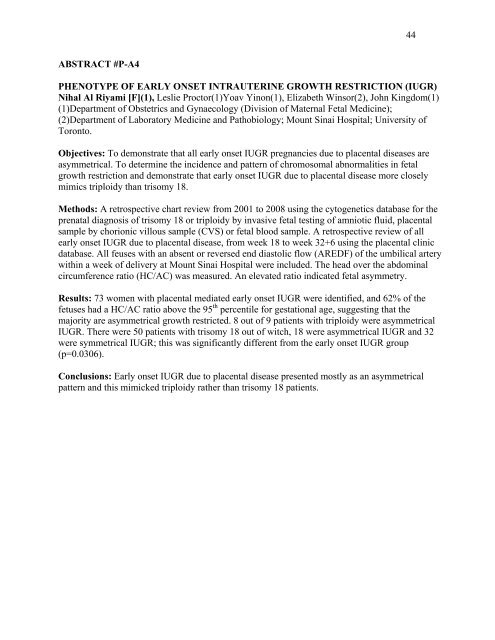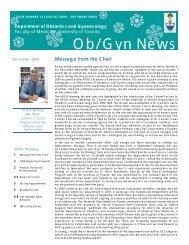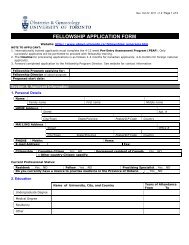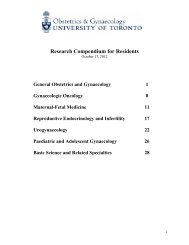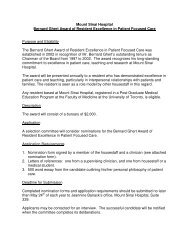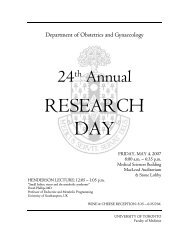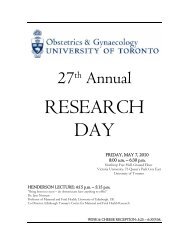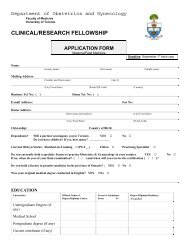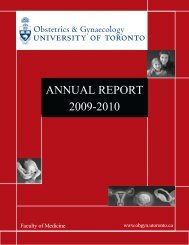research day - University of Toronto Department of Obstetrics and ...
research day - University of Toronto Department of Obstetrics and ...
research day - University of Toronto Department of Obstetrics and ...
You also want an ePaper? Increase the reach of your titles
YUMPU automatically turns print PDFs into web optimized ePapers that Google loves.
44<br />
ABSTRACT #P-A4<br />
PHENOTYPE OF EARLY ONSET INTRAUTERINE GROWTH RESTRICTION (IUGR)<br />
Nihal Al Riyami [F](1), Leslie Proctor(1)Yoav Yinon(1), Elizabeth Winsor(2), John Kingdom(1)<br />
(1)<strong>Department</strong> <strong>of</strong> <strong>Obstetrics</strong> <strong>and</strong> Gynaecology (Division <strong>of</strong> Maternal Fetal Medicine);<br />
(2)<strong>Department</strong> <strong>of</strong> Laboratory Medicine <strong>and</strong> Pathobiology; Mount Sinai Hospital; <strong>University</strong> <strong>of</strong><br />
<strong>Toronto</strong>.<br />
Objectives: To demonstrate that all early onset IUGR pregnancies due to placental diseases are<br />
asymmetrical. To determine the incidence <strong>and</strong> pattern <strong>of</strong> chromosomal abnormalities in fetal<br />
growth restriction <strong>and</strong> demonstrate that early onset IUGR due to placental disease more closely<br />
mimics triploidy than trisomy 18.<br />
Methods: A retrospective chart review from 2001 to 2008 using the cytogenetics database for the<br />
prenatal diagnosis <strong>of</strong> trisomy 18 or triploidy by invasive fetal testing <strong>of</strong> amniotic fluid, placental<br />
sample by chorionic villous sample (CVS) or fetal blood sample. A retrospective review <strong>of</strong> all<br />
early onset IUGR due to placental disease, from week 18 to week 32+6 using the placental clinic<br />
database. All feuses with an absent or reversed end diastolic flow (AREDF) <strong>of</strong> the umbilical artery<br />
within a week <strong>of</strong> delivery at Mount Sinai Hospital were included. The head over the abdominal<br />
circumference ratio (HC/AC) was measured. An elevated ratio indicated fetal asymmetry.<br />
Results: 73 women with placental mediated early onset IUGR were identified, <strong>and</strong> 62% <strong>of</strong> the<br />
fetuses had a HC/AC ratio above the 95 th percentile for gestational age, suggesting that the<br />
majority are asymmetrical growth restricted. 8 out <strong>of</strong> 9 patients with triploidy were asymmetrical<br />
IUGR. There were 50 patients with trisomy 18 out <strong>of</strong> witch, 18 were asymmetrical IUGR <strong>and</strong> 32<br />
were symmetrical IUGR; this was significantly different from the early onset IUGR group<br />
(p=0.0306).<br />
Conclusions: Early onset IUGR due to placental disease presented mostly as an asymmetrical<br />
pattern <strong>and</strong> this mimicked triploidy rather than trisomy 18 patients.


